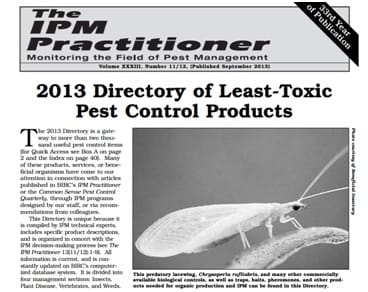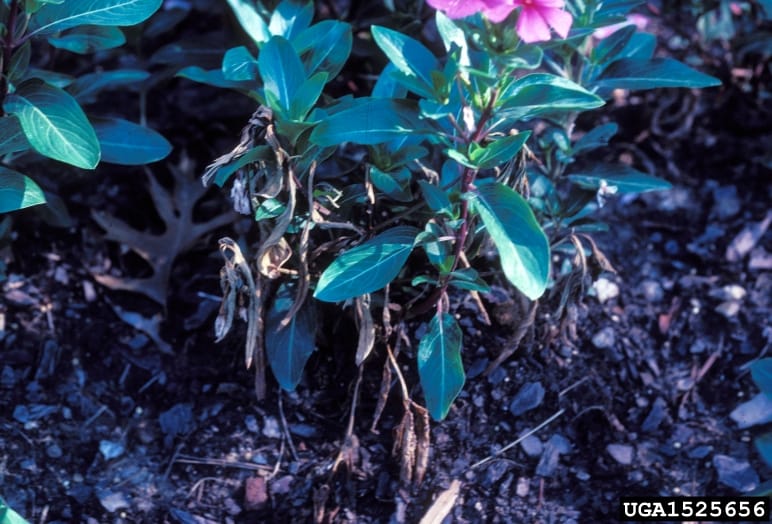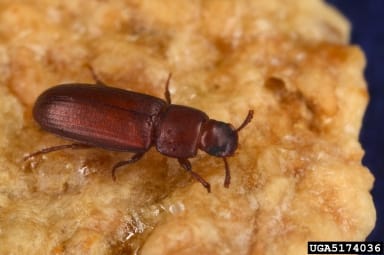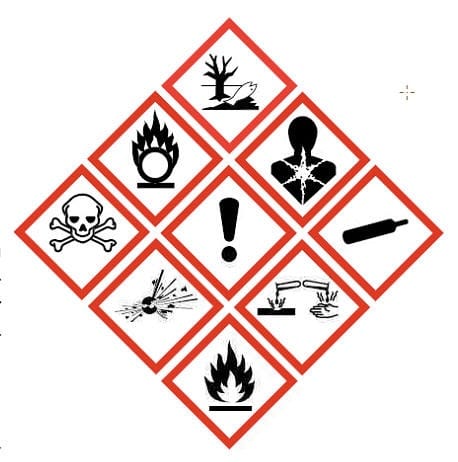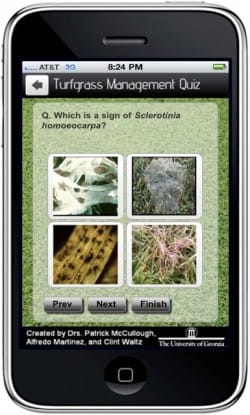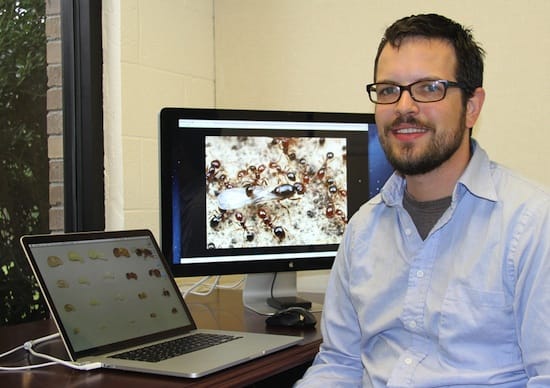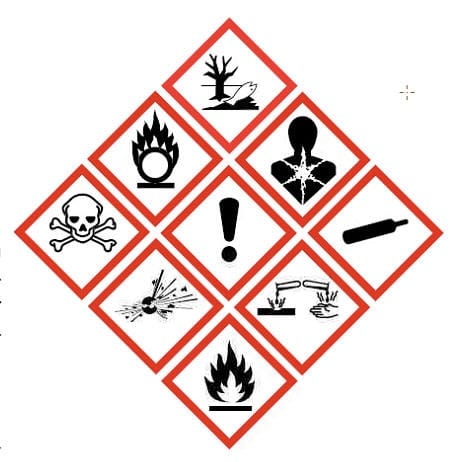Pest Control Alerts give the Georgia pest control industry current info from UGA and related university partners. On this Popular Press Articles page, we include articles of interest from media or others outside the university community. Since these come from writers outside UGA, we cannot vouch for all the info and the views expressed do not reflect the opinion of UGA or its partners. We merely include these here for your interest.
Pest Control Alerts
Brown Recluse Spider isn’t Typically a Southerner
Sharon Dowdy, News Editor with the University of Georgia College of Agricultural and Environmental Sciences
A University of Georgia researcher says brown recluse spiders in Georgia are being wrongly blamed for wounds they don’t cause.
“Most of the state of Georgia doesn’t even have brown recluse spiders,” said Nancy Hinkle, an entomologist with the UGA College of Agricultural and Environmental Sciences. “If the spiders in the state caused all the wounds that are reported as brown recluse bites, they would be some very busy spiders.”
The Brown Recluse is not a Southerner
From 2001 to 2007, Hinkle tracked verified findings of brown recluse spiders in Georgia. The study was prompted by Hinkle’s arrival from California.
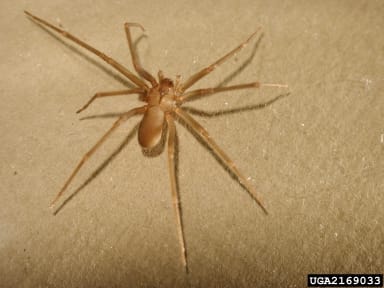
“When I first came to Georgia, I heard several people say they knew someone who’d seen or been seriously wounded by a recluse,” she said. “I found that odd since the recluse is a Midwesterner, not a Southerner.”
The brown recluse is mostly brown but has a darker, violin-shaped design where its legs attach. With its legs extended, it’s only about the size of a quarter.
Hinkle has received hundreds of spider samples from Georgians all across the state. Rick Vetter from the University of California at Riverside identifies the samples. He is the world’s expert on brown recluse spiders.
Only Two out of Twenty-five are Recluse Spiders
Lisa Ames with the UGA CAES Homeowner Insect and Weed Diagnostic Laboratory in Griffin also collects spider samples submitted by homeowners and pest control companies. In 2003, 2004 and 2005 she received an average of 25 samples each year. Only two samples annually were recluses.
Through 2007, the UGA scientists had collected only 14 verified brown recluse spiders. And they had confirmed the spider in just 26 of Georgia’s 159 counties, mostly in the northwest.
“Another reason for doing this study is to help the medical community rule out brown recluse bites from portions of the state that don’t have the spiders,” Hinkle said. “A diagnosis of a brown recluse bite in Savannah is highly questionable.”
Most Likely not Spider Bites
Hinkle hopes the study will educate Georgia’s medical community and reduce the number of erroneous recluse bite cases. A mark on the skin that looks like a spider bite could be something much more serious.
She believes many assumed brown recluse bites could be methicillin-resistant Staphylococcus aureus. MRSA is a type of staph infection that’s resistant to antibiotics like penicillin, amoxicillin and oxacillin. MRSA causes mild skin infections which result in pimples or boils. But it can also cause more serious skin lesions or infect surgical wounds.
MRSA and Brown Recluse Wounds can Look Similar
“Over the past five to 10 years, the number of MRSA cases has exploded,” Hinkle said. A MRSA infection can look like a brown recluse wound.
A brown recluse spider’s bite often isn’t the painful part of the experience. The spider’s venom destroys the tissue at the bite site. Several hours later, a blister-like sore appears and grows. It can become as small as a pin to 8 inches across.
Almost all brown recluse bites heal nicely without medical intervention, Vetter said. And in spite of all the horror stories, only 3 percent require skin grafts.
Incorrectly diagnosing MRSA as a spider bite, and vice versa, can result in a patient getting the wrong therapy, Hinkle said. “The required treatment for a brown recluse bite is totally different from the treatment needed for MRSA,” she said. “Common antibiotics don’t touch MRSA. And you obviously wouldn’t need to spray insecticides when you aren’t dealing with a spider problem.”
Peaceful Co-exsisters
Brown recluse spiders aren’t vicious and are not looking to bite people, Vetter said. A Kansas family collected more than 2,000 brown recluses from their home in six months. “They’ve been living there for eight years and still have shown no evidence of a single bite,” he said. “People tend to overreact and believe the worst.”
For more information:
Why You Need Not Fear the Poor, Misunderstood Brown Recluse Spider
IPM directory of least-toxic products available
Article taken from Southern Region IPM News
(Editor’s note – this guide lists low toxicity alternatives for pest control. It does not mention the effectiveness of each option. This can be a starting point for finding low toxicity options for pest control but more research will be needed to determine the efficacy of each option. WC)
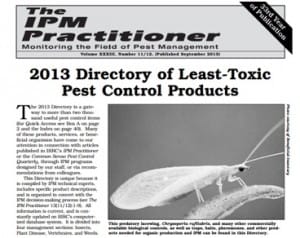 The IPM Practitioner’s 2013 Directory of Least-Toxic Pest Control Products is now available online. This Directory lists more than 2,000 products such as baits, traps, pheromones, microbials, biocontrol agents, and other materials needed for IPM.
The IPM Practitioner’s 2013 Directory of Least-Toxic Pest Control Products is now available online. This Directory lists more than 2,000 products such as baits, traps, pheromones, microbials, biocontrol agents, and other materials needed for IPM.
Contact information is provided for more than 600 national and international suppliers. The Directory can be found at the following link:
http://www.birc.org/Directory.htm
And take a look at the October 11 post in Insects in the City for a little more information about the directory and its publisher.
New fungicides for ornamental disease control
Jean Williams-Woodward, UGA Extension Plant Pathologist
Several fungicides for ornamental production have come on the market within the past couple of years. Below is a summary of some of the products.
Many of the products control Oomycete diseases including downy mildews and Pythium and Phytophthora root rot and blights. This is great news since there were few good Oomycete fungicide options available previously other than Subdue MAXX, Aliette and the numerous phosphonates/phosphites. Oomycete pathogens develop fungicide resistance readily.
Current research on Phytophthora and Pythium populations within GA nurseries and greenhouses has shown that approximately 5-25% of the isolates from individual production facilities are resistance to mefenoxam (Subdue MAXX). To reduce fungicide resistance development, always use products according to label rates and restrictions and rotate applications with products with a different mode of action (i.e. different FRAC numerical code).
| Brand Name | Active Ingredient | FRAC # | Sites1 | Diseases Controlled |
| Adorn | Fluopicolide | 43 | G, L, N | Downy mildew, Phytophthora, Pythium: Must be tank mixed with a product with a different mode of action (different FRAC #) for fungicide resistance management |
| Disarm O | Fluoxastrobin | 11 | G, N | Broad spectrum – Rhizoctonia, Phytophthora, downy mildew, powdery mildew, anthracnose, leaf rusts, various fungal leaf spots and blights |
| Micora | Mandipropamid | 40 | G, N | Downy mildew and Phytophthora foliar blight and root rot: Provides a good rotation partner to Subdue MAXX, Segway and Adorn. |
| Orvego | Ametoctradin + dimethomorph | 45 + 40 | G, N | Downy mildew and Phytophthora: Contains the same active ingredient as Stature fungicide. Use in rotation with products with different mode of action. |
| Pageant | Boscalid + Pyraclostrobin | 7 + 11 | G, L, N | Broad spectrum – Anthracnose, powdery mildew, various fungal leaf spots, Botrytis, downy mildew, Phytophthora, Rhizoctonia, Cylindrocladium |
| Palladium | Cyprodinil + Fludioxonil | 9 + 12 | G,L, N | Provides good Botrytis control, plus other diseases including Rhizoctonia, powdery mildew, Cylindrocladium, Sclerotinia, Sclerotium rolfsii, Fusarium, certain fungal leaf spots |
| Segway | Cyazofamid | 21 | G, L, N | Downy mildew, Phytophthora, Pythium. |
| Torque | Tebuconazole | 3 | G, L, N | DMI fungicide with same mode of action as Strike, Banner MAXX, and Systhane. Controls powdery mildew, rusts, Sclerotium rolfsii, black spot, and various other fungal leaf spot diseases. |
| Tourney | Metconazole | 3 | L, N | For use on woody ornamentals (not floriculture). DMI fungicide. Controls anthracnose, powdery mildew, rusts. |
| Trinity TR | Triticonazole | 3 | G, L, N | Supplemental labeling for use on ornamentals. DMI fungicide. Controls anthracnose, powdery mildew, Fusarium, Rhizoctonia, Sclerotium rolfsii, Sclerotinia, certain fungal leaf spots |
| Veranda O, Affirm | Polyoxin D | 19 | G, N | Botrytis, Colletotrichum, Alternaria, Fusarium, Rhizoctonia, Sclerotinia |
1 Location where product is registered for use: Greenhouse (G), Landscape (L), Nursery (N)
Better Trap on Tap for Red Flour Beetle Control
Source – Jan Suszkiw in the Southern Region IPM News
Better control of red flour beetles and other costly stored-product insect pests could be on hand, thanks to a new pitfall trap designed by U.S. Department of Agriculture (USDA) researchers.
According to chemist Peter Teal with USDA’s Agricultural Research Service (ARS), the commercial traps now used are typically dome-shaped devices baited with pheromones or other attractants that lure the beetles into pits or onto glue strips. However, the new design, named the “Terrestrial Arthropod Trap,” takes this “fatal attraction” to a new level, adds Teal, who leads the Chemistry Research Unit at the ARS Center for Medical, Agricultural and Veterinary Entomology in Gainesville, Fla.
He co-developed the technology with Lee Cohnstaedt of the ARSCenter for Grain and Animal Health Research in Manhattan, Kan., and Adrian Duehl and Richard Arbogast, both formerly with ARS at Gainesville.
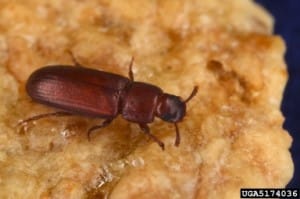
The red flour beetle, Tribolium castaneum, is a primary target of the team’s trap design research because the pest eats both raw and processed cereal grains. It commonly infests flour mills, but can also be found in warehouses, storage bins and household food pantries, causing millions of dollars in losses annually.
Among its features, the new trap is pyramid-shaped and sports slender fins that coax inquisitive beetles into a central pit where they can be captured. The trap is also fitted with light-emitting diodes (LEDs) whose colored light—set to wavelengths of 390 nanometers (nm)—attracts beetles from long distances, ensuring they get a whiff of pheromone as they approach.
In laboratory trials, red flour beetles visited LED traps set to 390 nm approximately 16 times versus two to five times for traps set to other wavelengths. Moreover, the team determined, positioning the LEDs at the trap’s top captured more beetles (approximately 55 total) than placing the diodes at the bottom (12 captured). Combining the LEDs with attractant made the pyramid design even more effective, capturing 70 beetles versus four using a standard dome design.
Read more about this ARS-patented technology in the October 2013 issue of Agricultural Research magazine.
Free video helps to provide training on the newly revised OSHA Safety Data Sheets
(Editors’ notes – these changes impact pesticide applicators in several ways:
- SDS sheets should replace the MSDS sheets used in the past. You will want to update your MSDS sheets with these new 16-section format Safety Data Sheets. These sheets need to be available to employees so they can understand the risks associated with using these chemicals at work.
- Employee training on the new system is required by Dec 1, 2013. The following article includes an online video to help with this requirement. Additional employee training may also be needed.
Pesticides will remain under US EPA regulation. EPA is not requiring pesticide labels to make any changes. The OSHA regulated SDS and the signal word will not match the EPA pesticide label. This OSHA training focuses on chemical label elements that are NON-pesticide.)
Original article found on this website
“Exposure to hazardous chemicals is one of the most serious threats facing American workers today,” said U.S. Secretary of Labor Hilda Solis. “Revising OSHA’s Hazard Communication standard will improve the quality and consistency of hazard information, making it safer for workers to do their jobs and easier for employers to stay competitive.” This update to the Hazard Communication Standard (HCS) will provide a common and coherent approach to classifying chemicals and communicating hazard information on labels and safety data sheets. Once implemented, the revised standard will improve the quality and consistency of hazard information in the workplace, making it safer for workers by providing easily understandable information on appropriate handling and safe use of hazardous chemicals.
|
Hazard Communication Standard In order to ensure chemical safety in the workplace, information about the identities and hazards of the chemicals must be available and understandable to workers. OSHA’s Hazard Communication Standard (HCS) requires the development and dissemination of such information:
Major changes to the Hazard Communication Standard
Employee training – This video explains the new GHS labeling system adopted by OSHA when they revised their hazard communication standard in 2012. Employers must provide training on this particular topic to their workers by no later than December 1, 2013. This video is free for employers to use for worker training, compliments of OSHA Training Services Inc. |
UGA mobile apps help professionals care for lawns
Sharon Dowdy, News Editor with the UGA College of Agricultural and Environmental Sciences
Four mobile applications designed by University of Georgia specialists are putting lawncare information at your fingertips, literally.
The turfgrass apps created by UGA College of Agricultural and Environmental Sciences faculty make turf management in Georgia readily available. Turfgrass Management, Turf Management Calculator, Turfgrass Weeds and Turf Management Quiz can all be downloaded from the UGA Turfgrass Team website at www.GeorgiaTurf.com or straight to a mobile device through iTunes.
A lite version
The most popular UGA turfgrass app is Turf Management Lite. This free app was created with students, homeowners and professionals in mind. It includes photos of turfgrass varieties, pests, weeds and diseases.
Mobile applications, or apps as they are commonly called, can be downloaded onto smart phones like Droids and iPhones as well as portable tablets like iPads.
“Back in 2009, mobile apps were fairly new to smart phones. We saw a great opportunity to put the information where it can be easily accessed by mobile phone, iPods and tablets, instead of publishing a telephone-book-sized publication,” said Patrick McCullough, a UGA turfgrass specialist based on the Griffin campus. The turfgrass apps are his brainchild.
“Rather than have to go to the office and get an Extension publication or go online to view a publication, turfgrass professionals can now access the information they need in the field,” he said.
In-depth subscription version
There are three versions of the first app: Turf Management Lite, Turf Management Subscription and Turfgrass Management – Spanish. The lite and Spanish versions are free, but the subscription version costs $20 per year.
The subscription version includes everything from the lite version, plus information on pest control applications and a pesticide database. “You can search for trade names as well, and it includes PowerPoint presentations from UGA turfgrass faculty,” McCullough said.
The Spanish version is very popular in the turfgrass industry. “We have folks in the industry that speak Spanish as their first language. This app is a nice opportunity for those who are fluent in Spanish or primarily communicate in Spanish at work to have research-based turfgrass advice,” he said.
The Spanish version has been downloaded in more than 40 countries across the globe.
Making calculations easy
In 2011, the Turfgrass Management Calculator app was released. “It’s a comprehensive program that covers all types of applications, pesticide rates, fertilizer requirements, topdressing sand requirements, and calibration of sprayers and spreaders. Users enter known values of equations – like how much area is needed for a pesticide treatment at a certain rate. The app then does the calculation for you,” McCullough said.
College students majoring in turfgrass management use the app to double-check their math when learning these calculations, he said. “Some of these are very complex formulas. You can enter information for two products with different application rates and see which is more cost effective.”
The calculator app costs $5 and includes more than 16,000 pre-programmed calculations. It can also convert units from standard to metric. “It’s really a great tool for turfgrass managers and professionals, but students can learn a lot from it, too,” McCullough said.
Flash cards and quizzes
The Turfgrass Weeds app was released in 2011. It is designed to help users learn turfgrasses and weeds through a series of flash cards. “The cards reshuffle so users can continue to study and learn turfgrass species and weeds,” he said.
Just a few months ago, the UGA Turfgrass Team released its latest turfgrass app – Turfgrass Management Quiz.
“This app is a trivia style education game. You get test questions or photos with four choices to answer. You tap the correct answer, and when you’re done, you get a quiz score,” McCullough said.
The quiz app has two modes – quiz mode and study mode. Quiz mode scores your answers and study mode helps you get the correct answer.
“This app is perfect for students, but it can also be used by any turfgrass professional who wants to brush up on their knowledge. It’s a fun application that challenges you to get the best score, improve on your score and test your knowledge,” he said.
The new turfgrass apps are perfect for those who like to learn on their phones or mobile devices. UGA publications are also available online for computer users and in print form for those who still like the feel of a book in their hands.
“(Mobile apps) are a new technology – a new method to get information in the hands of the end user. We are trying to make it easier for people to get UGA turfgrass recommendations so it just makes sense for us to create these programs,” McCullough said.
To download the UGA turfgrass mobile apps or get more information on the turfgrass research at UGA, see the website www.GeorgiaTurf.com.
UGA researcher studies fire ant genetics to better understand ant’s success
A newly-hired University of Georgia entomologist hopes to develop genetic resources to understand fire ant success in the southeastern United States. Ultimately, this research could lead to new methods to reduce the number of fire ants inflicting pain on humans and taking over lawns and pastures across Georgia.
“I’m searching for methods to knock down specific genes in the fire ant. The ability to perturb gene function can help us better understand the basis of traits related to fire ant social structure and population density,” said Brendan Hunt, an entomologist in the UGA College of Agricultural and Environmental Sciences and the newest faculty member of the Griffin campus.
Knowing more about fire ant genetics could lead to new control applications, he said.
Hunt earned a doctorate at Georgia Tech where he studied fire ant genetics and molecular evolution of social insects. He was also involved with the sequencing of the fire ant genome.
He is also interested in how environmental factors affect animal development. Hunt says a “model example” of the environment’s influence on development can be found in honeybees and fire ants.
“A female honeybee or fire ant egg can develop either into a queen or a worker and based on nutritional and feeding differences during their development,” he said. “A queen actively produces and lays eggs for a long time and lives for a long time while a worker is basically sterile.”
To build his research program at UGA, Hunt is collecting fire ants, an easy task as he’s found plenty living outside his office. “They are everywhere on this campus, which is great for me. One of the reasons fire ants are so successful is that they love mowed lawns, meadows and farmland,” Hunt said. In addition to studying fire ants, Hunt teaches undergraduate classes on the UGA Griffin campus.
For information on how to control fire ants in Georgia, see the UGA CAES publication “Managing Imported Fire Ants in Urban Areas” at www.caes.uga.edu/publications.
Free video helps to provide required OSHA training on the newly revised Safety Data Sheets
(Editors’ notes – these changes impact pesticide applicators in several ways:
- SDS sheets should replace the MSDS sheets used in the past. You will want to update your MSDS sheets with these new 16-section format Safety Data Sheets. These sheets need to be available to employees so they can understand the risks associated with using these chemicals at work.
- Employee training on the new system is required by Dec 1, 2013. The following article includes an online video to help with this requirement. Additional employee training may also be needed.
Pesticides will remain under US EPA regulation. EPA is not requiring pesticide labels to make any changes. The OSHA regulated SDS and the signal word will not match the EPA pesticide label. This OSHA training focuses on chemical label elements that are NON-pesticide.)
Original article found on this website
“Exposure to hazardous chemicals is one of the most serious threats facing American workers today,” said U.S. Secretary of Labor Hilda Solis. “Revising OSHA’s Hazard Communication standard will improve the quality and consistency of hazard information, making it safer for workers to do their jobs and easier for employers to stay competitive.” This update to the Hazard Communication Standard (HCS) will provide a common and coherent approach to classifying chemicals and communicating hazard information on labels and safety data sheets. Once implemented, the revised standard will improve the quality and consistency of hazard information in the workplace, making it safer for workers by providing easily understandable information on appropriate handling and safe use of hazardous chemicals.
|
Hazard Communication Standard In order to ensure chemical safety in the workplace, information about the identities and hazards of the chemicals must be available and understandable to workers. OSHA’s Hazard Communication Standard (HCS) requires the development and dissemination of such information:
Major changes to the Hazard Communication Standard
Employee training – This video explains the new GHS labeling system adopted by OSHA when they revised their hazard communication standard in 2012. Employers must provide training on this particular topic to their workers by no later than December 1, 2013. This video is free for employers to use for worker training, compliments of OSHA Training Services Inc. |

